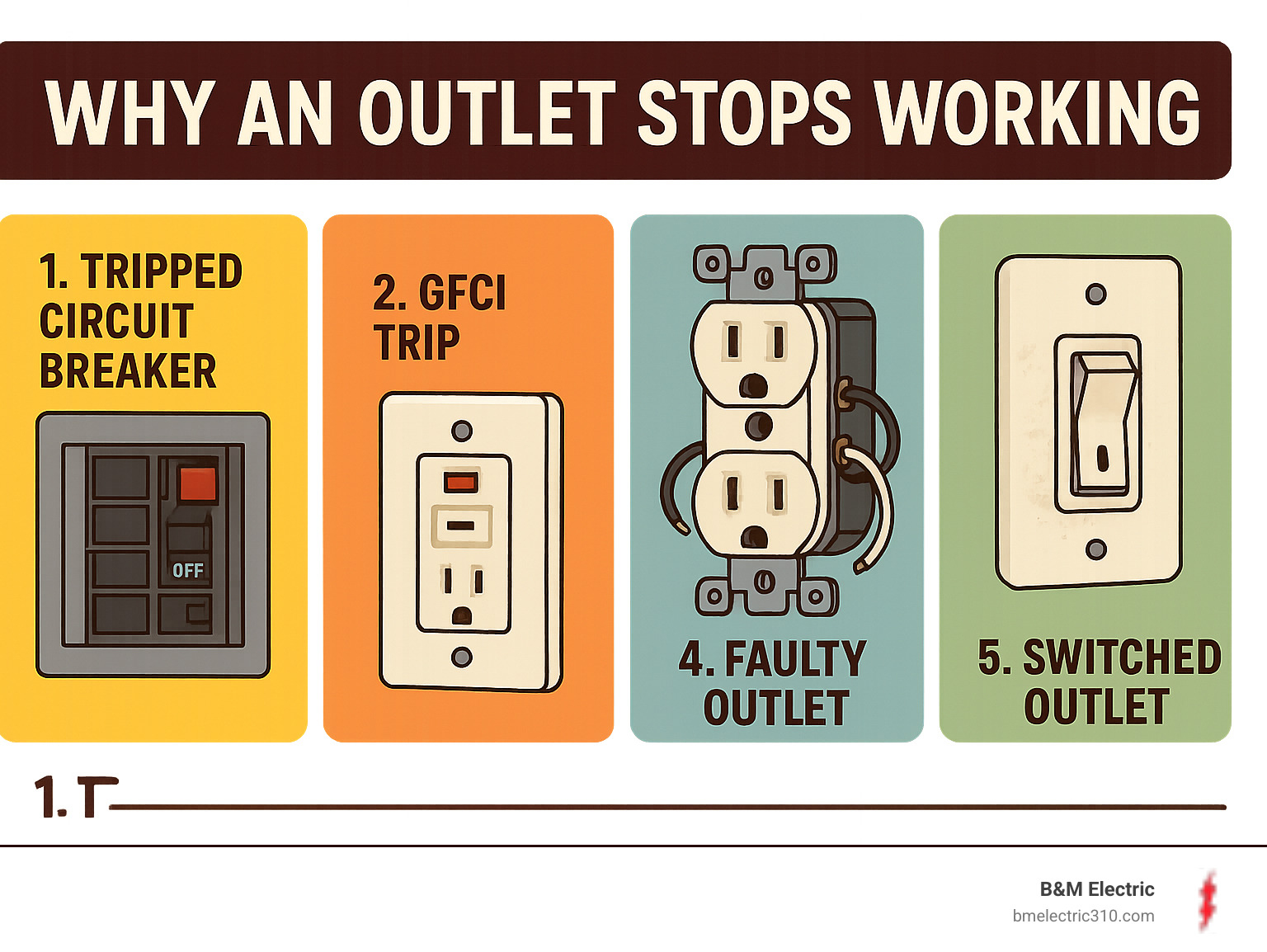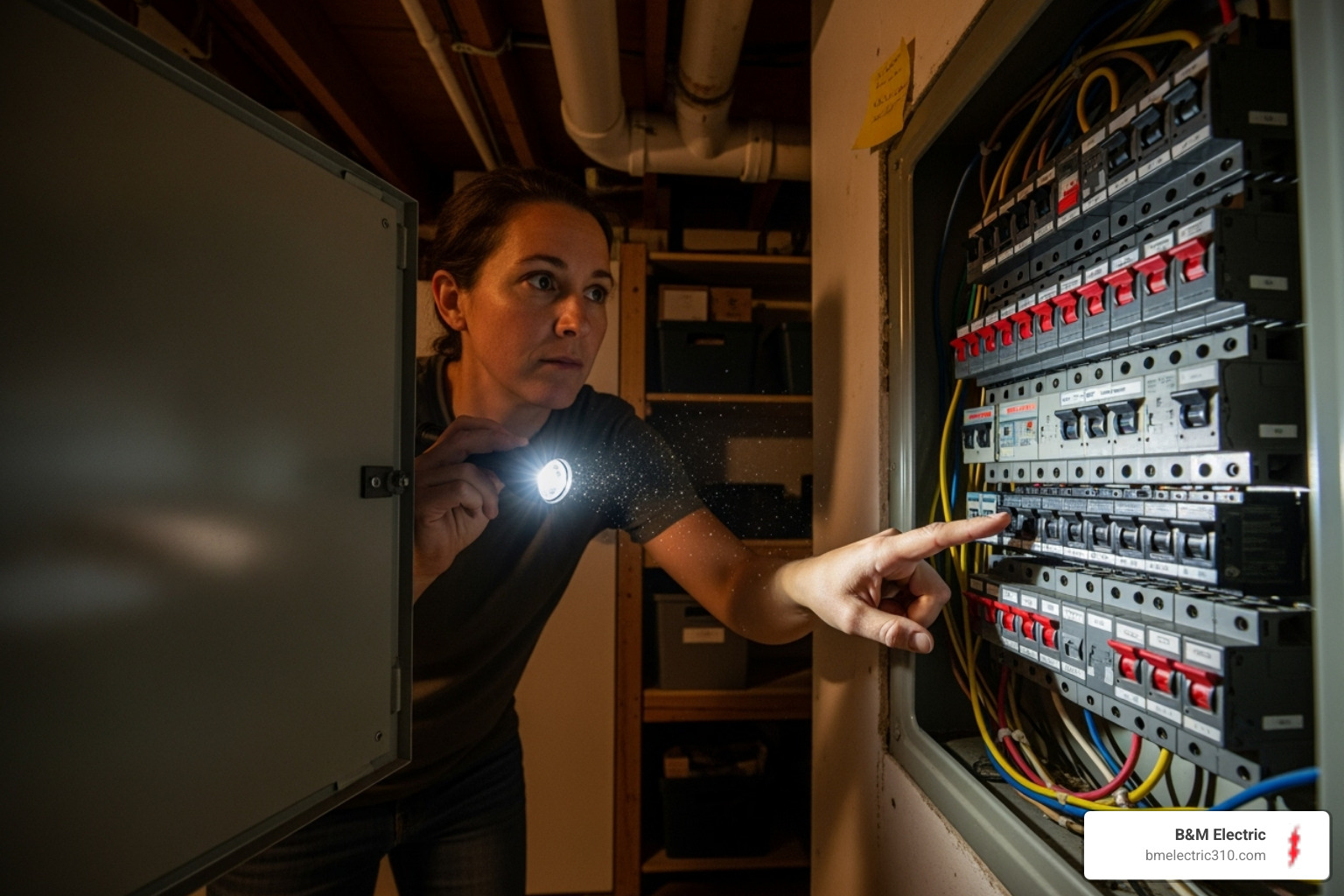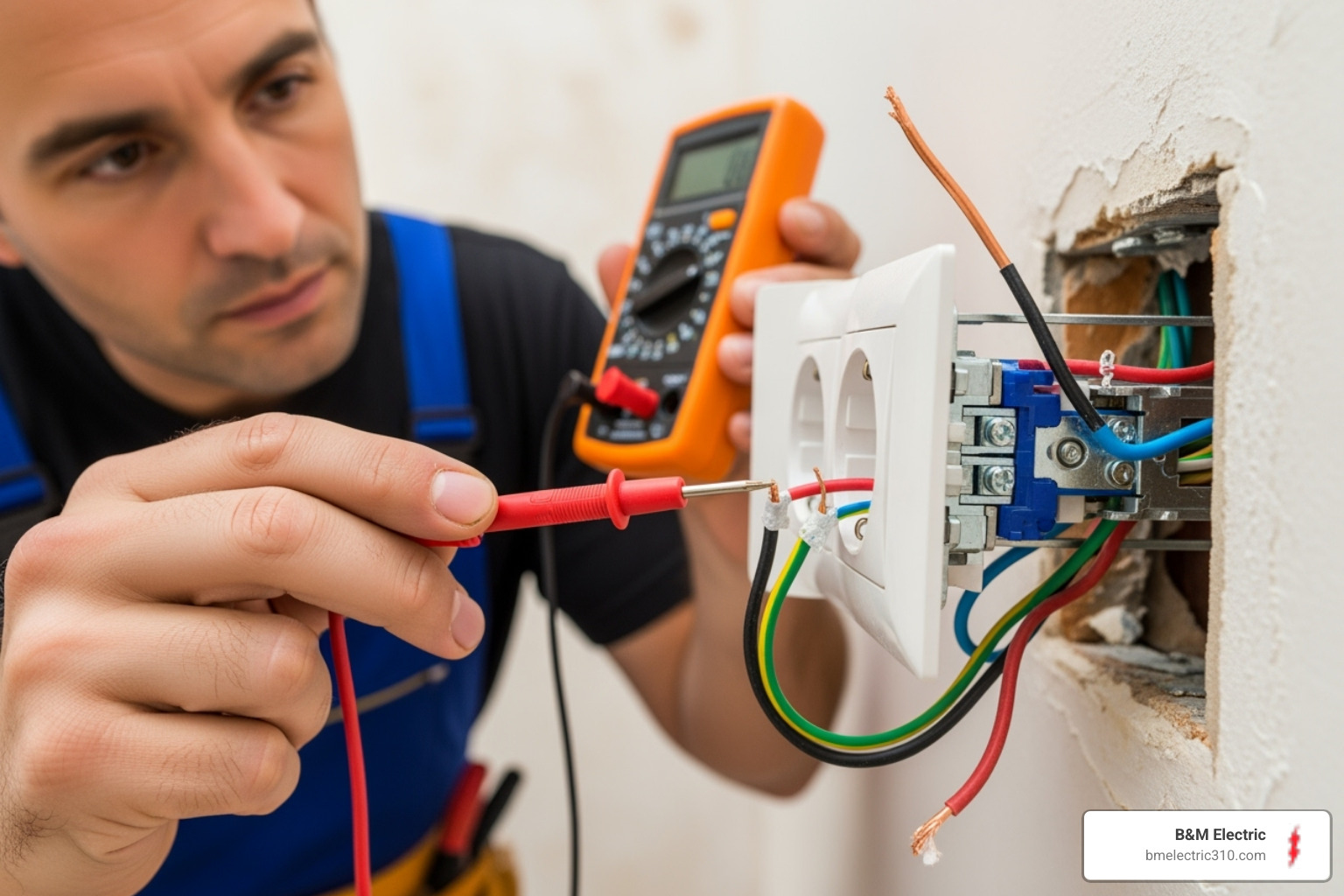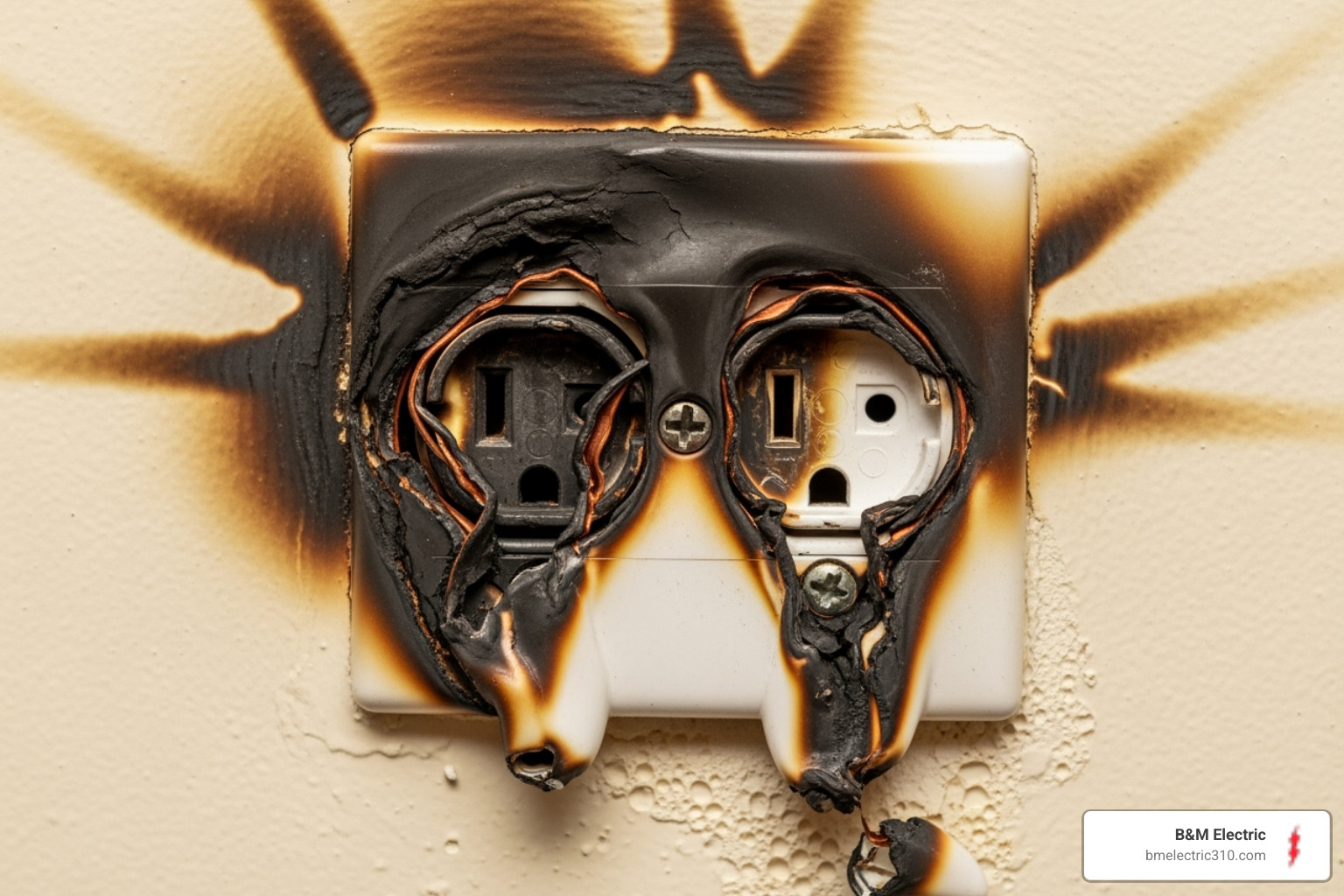No Power, No Problem: Simple Fixes for Outlets That Won’t Work
By B&M ElectricOctober 1, 2025
Outlet not working: Top 5 Easy Fixes
When Your Outlet Won’t Work: Quick Solutions for a Common Problem
When you plug in your phone charger and nothing happens, an outlet not working can turn a simple task into a frustrating problem. The good news? Many outlet issues have simple fixes you can try before calling an electrician.
Quick troubleshooting steps for a dead outlet:
- Check the circuit breaker – Look for a tripped breaker in your electrical panel
- Reset GFCI outlets – Press the “RESET” button on any GFCI outlets nearby
- Test wall switches – Try flipping switches that might control the outlet
- Try a different device – Rule out a faulty appliance or cord
- Look for visible damage – Check for scorch marks, melting, or burning smells
Most outlet failures stem from a handful of common causes. A tripped circuit breaker cuts power to multiple outlets at once. GFCI outlets in bathrooms and kitchens can trip and affect other outlets downstream. Sometimes the outlet is controlled by a wall switch you forgot about, or the problem is actually with your device, not the outlet itself.
However, some outlet problems signal serious electrical hazards. If you see sparks, smell burning, or notice scorch marks, stop immediately and call a professional electrician. These warning signs indicate dangerous conditions that require expert attention.
The key is knowing which problems you can safely tackle yourself and which ones need professional help. Let’s walk through the simple checks that solve most outlet issues – and help you recognize when it’s time to call B&M Electric.

First Steps: Simple Checks for a Dead Outlet
When you find an outlet not working, don’t immediately call an electrician. Many outlet problems have simple solutions you can handle yourself in minutes. Most failures stem from a few common causes, so following a logical troubleshooting pattern can often solve the issue. Let’s walk through the easy checks that fix most outlet problems.

Check Your Circuit Breaker
Your electrical panel is the control center for your home’s power. When an overloaded circuit or a short circuit occurs, the breaker trips to protect your home from damage.
A tripped breaker can be sneaky. Unlike a light switch that’s clearly on or off, a tripped breaker sits in a middle position that can be easy to miss.
Head to your electrical panel (usually in the garage, basement, or a utility closet). A tripped breaker won’t be flipped all the way to “OFF.” Instead, it’ll be sitting somewhere between “ON” and “OFF.”
To reset it, push the switch firmly to “OFF” first, then push it back to “ON.” You should feel it click into place. If the breaker immediately trips again, there’s still a problem on that circuit—either too much demand or a fault that needs professional attention.
One tripped breaker can knock out multiple outlets, so this one fix might restore power to several dead outlets. If you’re dealing with recurring breaker problems, this guide on what to do if your electrical breaker panel has issues provides helpful safety information.
Troubleshooting a GFCI outlet not working
GFCI outlets, with their “TEST” and “RESET” buttons, are lifesavers found in bathrooms, kitchens, and outdoor areas. They detect electrical imbalances and shut off power in milliseconds to prevent shock.

The tricky part about GFCI outlets is that they can control other outlets. When a GFCI trips, it often takes several “downstream” outlets with it. So if your bedroom outlet stops working, the culprit might be a GFCI outlet in your bathroom or garage.
Look for any GFCI outlets in your home and press the “RESET” button firmly until you hear it click. If it was tripped, this should restore power not just to that outlet, but potentially to other outlets that seemed dead.
If the GFCI won’t reset or immediately trips again, don’t keep trying. This usually means there’s moisture, a faulty appliance, or damaged wiring that needs professional attention. You can learn more about what are GFCI outlets and their importance for home safety.
When you find yourself dealing with GFCI outlets that keep tripping, it’s time to give us a call. Persistent tripping is your outlet’s way of saying “something’s not right here.”
Is It a Switched or Half-Hot Outlet?
Here’s a common scenario: you move into a new place, plug in a lamp, and nothing happens. You assume the outlet not working is broken, but it may just be waiting for you to flip a wall switch.
Many homes have switched outlets or half-hot outlets, where one or both receptacles are controlled by a wall switch. This allows you to control a lamp from across the room.
The confusion happens because these switched outlets often look identical to regular outlets. There’s no obvious sign that it’s controlled by a switch.
Look around the room for wall switches that don’t seem to control anything obvious. Try flipping each switch while testing your outlet. You might find that a switch you thought was useless actually controls the outlet you thought was dead.
Half-hot outlets are particularly sneaky because only one of the two receptacles is switched—the other stays on all the time. So you might plug something into the bottom outlet and get nothing, then try the top outlet and suddenly have power.
Rule Out the Appliance
Before calling an electrician, consider a simpler possibility: the problem might be the device you’re trying to plug in, not the outlet at all.
It’s easy to overlook a damaged cord or faulty device when troubleshooting an outlet not working.
Grab something you know works—a phone charger or a lamp—and plug it into your “dead” outlet. If it springs to life, congratulations! Your outlet is fine, and you’ve just identified a faulty appliance.
Conversely, take the device that wasn’t working and try it in an outlet you trust. If it still doesn’t work, you’ve found your answer. A short in the appliance or a damaged cord can make a perfectly good outlet seem broken.
This simple swap test takes thirty seconds and can save you hours of unnecessary troubleshooting.
Why Is My Outlet Not Working? Common Culprits You Can Fix
When the simple fixes don’t solve your outlet not working problem, it’s time to dig a little deeper. The culprit might be hiding inside the outlet itself or in the connections behind it. While some of these issues can be tackled by handy homeowners, they also mark the point where calling B&M Electric for professional Electrical Repairs becomes the smarter choice.

What to do when an outlet is not working but the breaker isn’t tripped
This scenario stumps many homeowners. You’ve got an outlet not working, but the breaker looks fine—it hasn’t tripped. This puzzling situation usually points to problems within the outlet itself or somewhere along the wiring path.
The most common culprit is loose connections. Over time, plugging and unplugging devices or even household vibrations can loosen wires. A loose connection at one outlet can cut power to others downstream on the same circuit.
Sometimes the problem isn’t where you’d expect it. A faulty GFCI outlet upstream might be the real troublemaker. Even though the dead outlet you’re testing isn’t a GFCI itself, it could be protected by one located in your bathroom, kitchen, or garage. When that distant GFCI trips, it silently cuts power to all the standard outlets connected to it.
Another sneaky issue is a broken neutral wire. Your electrical circuit needs both a hot wire (bringing power) and a neutral wire (carrying unused power back) to complete the loop. If that neutral connection breaks, your devices won’t work even though the hot wire might still show voltage with a tester.
Sometimes the outlet itself is simply worn out. The internal metal contacts can lose their spring tension over years of use, preventing a solid connection with your plugs. In rare cases, the circuit breaker can fail internally while still appearing to be in the “on” position.
The Dangers of Loose Wiring and Connections
Loose wiring isn’t just an inconvenience; it’s a serious fire hazard demanding immediate attention. Many homes, particularly older ones, use less reliable “backstab” connections where wires are pushed into holes instead of secured around screw terminals. These are prone to loosening over time.
The dangers of loose connections extend beyond a dead outlet. Loose wires create arcing (electricity jumping across gaps), which generates intense heat and sparks. This can damage wiring and create a fire risk inside your walls. Loose connections also cause overheating from electrical resistance, which can melt wire insulation and damage the outlet. Warning signs include buzzing or humming sounds, flickering lights, or a burning smell.
Before an outlet completely dies, you’ll often experience intermittent power—devices might turn on and off randomly, or lights might flicker when you use certain outlets. These aren’t just annoying quirks; they’re critical warning signs that shouldn’t be ignored.
If you’re dealing with older outlets that feel wobbly when you plug things in, or if you notice any of these warning signs, it’s time to take action. Our guide on How to Fix Loose Electrical Outlets offers more detailed insights, but remember—when in doubt, it’s always safer to call a professional.
Burned-Out and Defective Outlets
Sometimes an outlet not working is because the outlet itself has failed. Outlets wear out from age, overloads, or power surges.
Scorch marks or discoloration around the outlet slots are clear warning signs that overheating has occurred. These black or brown marks indicate a dangerous situation has already developed. Similarly, any burning smell coming from an outlet means that wires or plastic components are overheating right now.
If you see melted plastic on the outlet or its cover plate, this is an extremely dangerous situation that requires immediate attention. The same goes for any outlet that feels hot to the touch—outlets should never feel warm or hot.
Another telltale sign of a worn-out outlet is when plugs fall out easily or feel loose. The internal metal contacts have lost their spring tension and can no longer grip plugs securely. This creates gaps that lead to arcing and overheating—the exact conditions that cause fires.
Most electrical outlets have a lifespan of 15-20 years. If your home has outlets older than this, especially in high-use areas, they might be ready for replacement. A burned-out outlet isn’t just an inconvenience—it’s a major fire hazard that needs immediate professional attention.
For more insights on electrical issues common in our South Bay service area, check out our article on Common Electrical Issues in Redondo Beach. If you notice any of these danger signs, don’t attempt a DIY fix—call B&M Electric right away.
Danger Signs: When to Stop and Call a Professional
While troubleshooting an outlet not working can be satisfying, there’s a fine line between helpful DIY and dangerous territory. Electricity doesn’t give second chances, and what seems like a simple fix can quickly become a life-threatening situation. At B&M Electric, we’ve seen too many close calls from well-meaning homeowners who pushed beyond safe limits. Knowing when to step back and call us as your trusted Residential Electrician could literally save your life and your home.

Warning Signs You Shouldn’t Ignore
Some electrical symptoms are nature’s way of screaming “STOP!” If you notice any of these danger signals, put down your tools immediately and call a professional. These aren’t just inconveniences—they’re urgent warnings that something dangerous is happening inside your walls.
Sparks flying from an outlet are never normal, despite what you might think. A tiny spark when you plug something in can be typical, but large sparks, continuous sparking, or sparks when nothing’s being plugged in mean serious electrical faults are occurring. This is your cue to back away slowly.
The unmistakable smell of burning plastic or wires should send you straight to the phone. This odor means insulation is melting somewhere in your electrical system, and you’re potentially minutes away from a fire starting inside your walls. Don’t try to locate the source—just call us immediately.
Buzzing, humming, or crackling sounds coming from outlets or walls indicate loose connections creating dangerous arcing. Electricity should flow silently. When you hear it working, that’s electrical energy turning into heat and sparks where it shouldn’t.
Scorch marks or dark discoloration around outlets tell a story of overheating that’s already happened. These black or brown marks are evidence that temperatures got hot enough to burn materials. The outlet may seem fine now, but the damage is done, and it’s likely to happen again—possibly worse next time.
An outlet that feels warm or hot to the touch is crying out for help. Outlets should remain cool even when devices are plugged in. Heat means excessive current or faulty components, and that heat has nowhere to go but into your walls.
Circuit breakers that keep tripping are doing their job—protecting you from a dangerous situation. If a breaker immediately trips after you reset it, or trips repeatedly without obvious cause, there’s a persistent fault that needs professional diagnosis. Don’t keep resetting it hoping it will “stick.”
Why DIY Can Be Dangerous
We love a good DIY spirit—there’s real satisfaction in fixing things yourself! But electricity operates by different rules than that leaky faucet or squeaky door. The margin for error is essentially zero, and the consequences of mistakes can be catastrophic.
Electric shock is the most immediate danger. Even experienced electricians treat every wire as potentially live because electricity can seriously injure or kill in an instant. Without proper training, safety equipment, and knowledge of how to test circuits safely, you’re essentially playing electrical roulette.
Fire hazards from electrical mistakes are particularly insidious because they often start inside walls where you can’t see them. Improper connections, wrong wire sizes, or loose terminations can smolder for hours or days before erupting into flames. By then, the fire may have spread throughout your home’s structure.
The National Electrical Code exists for good reasons—it’s written in the blood of past electrical accidents. Professional electricians like our team study these codes extensively and stay current with updates. DIY work that doesn’t meet code standards isn’t just potentially dangerous; it can void insurance coverage and create legal liability.
Complex diagnosis requires specialized tools that most homeowners don’t own. Multimeters, circuit tracers, and other testing equipment are essential for safely identifying problems. Without them, you’re essentially working blind in a system where invisible energy can kill.
Perhaps most dangerously, a quick DIY fix might make symptoms disappear while leaving the root cause untouched. That outlet not working might start working again after you jiggle some wires, but the underlying problem could be getting worse, creating a hidden time bomb in your walls.
We’ve built our reputation over 50 years by safely resolving Electrical Problems in Palos Verdes Homes and throughout the South Bay. When you see those danger signs, don’t gamble with your family’s safety—call us for a professional solution that will last.
Frequently Asked Questions about Non-Working Outlets
When an outlet not working has you stumped, you likely have questions. Here are answers to the most common ones we’ve heard after 50 years of serving South Bay homeowners, helping you understand your home’s electrical system.
Why did multiple outlets in a room stop working at once?
When several outlets go dead simultaneously, it often makes troubleshooting easier because it points to a single interrupted power source.
A single tripped breaker or a tripped GFCI outlet often controls multiple “downstream” outlets on the same circuit. For example, when a GFCI outlet in a bathroom trips, it can cut power to an outlet in an adjacent bedroom.
A loose connection or fault in the first outlet of a series can also cause all subsequent outlets to lose power. Outlets are typically wired in a “daisy-chain” pattern, where power flows from one outlet to the next. If something goes wrong with the first outlet in the series, every outlet downstream loses power, even if your circuit breaker hasn’t tripped.
This is why we always start troubleshooting by checking GFCI outlets first, then working our way through the circuit systematically.
Can I use an adapter for a three-prong plug in a two-prong outlet?
We get this question a lot, especially from folks living in older homes with those vintage two-prong outlets. Yes, you can buy adapters at any hardware store, but here’s the thing – they bypass the critical grounding safety feature that protects you from electric shock.
That third, round prong on modern plugs isn’t just for show. It’s your safety lifeline, providing a path for dangerous electrical current to flow safely to the ground instead of through you if something goes wrong inside your appliance. When you use an adapter, you’re essentially removing that protection.
This increases the risk of electric shock significantly. If there’s an internal fault in your appliance or a problem with the wiring, you could become the path that electricity takes to reach the ground – and that’s a situation nobody wants to be in.
The safest solution is to have an electrician upgrade the outlet.Upgrading to GFCI Outlets is a great option for ungrounded circuits because GFCI outlets can provide excellent shock protection even when there’s no separate ground wire present in older wiring systems.
What’s the difference between a tripped breaker and a blown fuse?
This question usually comes from homeowners who’ve just moved into an older home and finded they have a fuse box instead of a modern breaker panel. Both serve the same essential purpose – protecting your home from electrical overloads – but they work very differently.
A tripped breaker is a switch that can be reset. When there’s an overload or short circuit, the breaker flips to the “OFF” position (or sometimes gets stuck in the middle). You can restore power by firmly pushing the switch all the way off, then back to “ON.” It’s reusable and designed to trip and reset thousands of times over its lifespan.
A blown fuse is a single-use safety device found in older homes that melts to break the circuit and must be completely replaced. Inside each fuse is a thin metal strip that’s designed to melt when too much current flows through it. Once it melts, that’s it – the fuse is done, and you need to screw in a brand new one.
You’ll know a fuse has blown because the little window often shows a broken or blackened metal strip inside. Unlike resetting a breaker, fixing a blown fuse means a trip to the hardware store and making sure you buy the exact same amperage rating as the one that blew.
While fuse boxes can work reliably for decades, most homeowners eventually upgrade to breaker panels for the convenience and improved safety features they offer.
Get Your Power Back Safely with a Torrance Electrician
When you’re dealing with an outlet not working, the frustration can be real. We’ve walked you through the most common troubleshooting steps that can solve many outlet problems right away. From checking your circuit breaker for a simple trip to resetting a GFCI outlet that’s protecting other outlets downstream, these quick fixes often get your power flowing again.
Sometimes the solution is as simple as finding you have a switched outlet controlled by a wall switch you forgot about, or realizing the problem isn’t with your outlet at all—just a faulty device or cord that needs replacing.
But we’ve also covered the more serious issues that require professional attention. Loose wiring connections behind your outlets can create dangerous arcing and fire hazards. Burned-out outlets with scorch marks or melting plastic are clear warning signs that shouldn’t be ignored. When outlets feel hot to the touch, emit burning smells, or produce sparks, it’s time to stop troubleshooting and prioritize safety.
Safety always comes first when dealing with electricity. While it’s great to handle simple resets and checks yourself, complex wiring issues require the specialized tools and expertise that only a licensed electrician can provide. The National Electrical Code exists for good reason—ensuring electrical work is done safely and correctly.
At B&M Electric, we’ve been serving Torrance and the South Bay communities for 50 years. We understand how an outlet not working can disrupt your daily routine, and we’re here to provide the dependable service you need with the personal touch you deserve. Our experienced team knows how to diagnose electrical problems quickly and fix them permanently, giving you peace of mind along with restored power.
Whether you’re dealing with a stubborn dead outlet, need to upgrade old two-prong outlets to modern GFCI protection, or want a complete electrical safety inspection, we’re ready to help. For reliable outlet and switch repairs in the South Bay, trust our experienced team to get the job done right. Contact us for all your Torrance outlets & switches services.